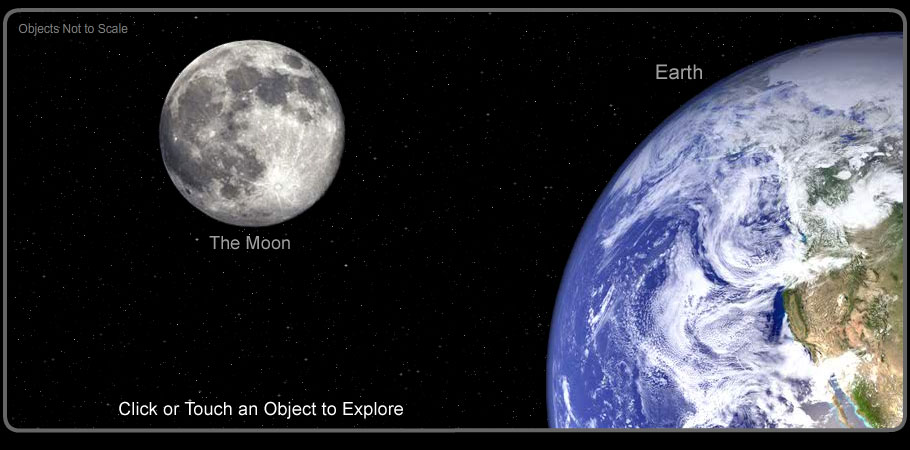A Blue Miracle
As we leave behind the dense clouds of Venus, we next encounter a truly remarkable sight. As we approach the third planet from the Sun, we see a shiny blue sphere of unimaginable beauty, partnered with a singular, large rocky Moon. A delicate veil of thin white clouds encompasses this blue globe. The blue color of this unusual world is caused by liquid water, an rare sight in the Solar System. In fact, this truly unique gift is known to exist only on this one planet. The blue spaces are broken by rocky shapes covered with a color we have never seen before. The beautiful browns of the land masses are painted with various shades of green. These are life forms. This planet is home to living organisms, making it potentially unique in the entire universe. This is the Terran system, comprised of the planet Earth and its lonely Moon.
The Wonder of life
The Terran system is home to the only planet in the universe known to contain the miracle of life. And life on the Earth exists in a myriad of forms and varieties. It is believed that life first started in the Earth about 3.5 billion years ago. These early life forms were simple, single-celled organisms that lived in water. Early life forms were able to capture the energy of the sun through a process known as photosynthesis. Through the miracle of cellular mutation and environmental change, life has evolved in to unimaginably complex forms. Today there are millions of species of animals and plants inhabiting the Earth. One of these creatures even developed self awareness, the intelligence to question its own existence, and the driving curiosity to explore its environment. That creature is man.
The road to modern life forms has been a rocky one. Because our Solar System is populated by a variety of small bodies such as asteroids and comets, there have been many times in Earth's past when life almost didn't survive. In fact, many scientists believe that there have been five mass extinction events since life first exploded on Earth. The last of these events occurred about 65 million years ago when an asteroid larger than mount Everest smashed in to the planet. The impact occurred in an area known as Chicxulub, near the eastern coast of Mexico. That impact and the resulting environmental changes are believed to have wiped out more than half of all species on the planet, including the mighty dinosaurs. Some scientists believe that this event paved the way for the mammals to take control of the planet, which eventually led to the development of modern humans.
The Goldilocks Zone
The Terran system is locates in an area of the Solar System that is not too hot and not too cold. Astronomers refer to this area as the Goldilocks zone, or the habitable zone. This thin ring around the Sun begins just beyond the orbit of Venus and extends to just before the orbit of Mars. This is the area where water can exist in its liquid form. And water is the most important factor in supporting life as we know it. If the Earth was too close to the sun, the water and oceans on the planet would boil away. If it were too far, all of the liquid water on the planet would freeze solid. Fortunately, the Terran system exists in this zone where everything is just right. It is because of this that our planet has been blessed with liquid water and life.
The Double Planets
The Earth's neighbor in space is the Moon. It it the planet's only natural satellite. It is very large in comparison to its parent planet, about a quarter as large. This leads some astronomers to consider the Terran system a double planet system. However, since the common center of mass around which both bodies revolve is located beneath the surface of the Earth, the Terran system is officially labeled as a planet-satellite system. Leading theories suggests that the Moon was formed when a small planet the size of Mars smashed into the early Earth about 4.5 billion years ago. The iron cores of the two planets merged, giving the Earth a larger metal core than the other terrestrial planets. A large portion of the crust and mantles of the two planets was thrown out into space, where it formed a ring of material. This ring of material eventually coalesced to form the Moon.
When the Moon first formed, it was much closer to the Earth. It only took 20 days to orbit the planet instead of the 28 days it takes today. At this time, a day on Earth was only 18 hours long. Since then, the Earth's rotation has slowed down and the Moon has been slowly drifting away. Today, the Moon moves about 1.6 inches farther away each year.
The Moon plays a very important role in the Terran system. Its gravity helps to keep the Earth stable on its axis. Without it, the axis of the Earth would wobble wildly, making it difficult for life to exist. The Moon is also responsible for the ocean tides on Earth. Its gravity pulls on the water, causing a slight elliptical bulge. As the Earth rotates through this bulge, the sea levels rise and fall by several feet. Many scientists believe that life may not have been possible on Earth if there was no Moon.




